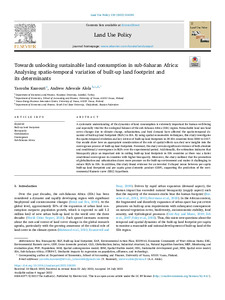Towards unlocking sustainable land consumption in sub-Saharan Africa : Analysing spatio-temporal variation of built-up land footprint and its determinants
Kassouri, Yacouba; Alola, Andrew Adewale (2022-08-04)
Kassouri, Yacouba
Alola, Andrew Adewale
Elsevier
04.08.2022
Julkaisun pysyvä osoite on
https://urn.fi/URN:NBN:fi-fe2022080452780
https://urn.fi/URN:NBN:fi-fe2022080452780
Kuvaus
vertaisarvioitu
© 2022 The Author(s). Published by Elsevier Ltd. This is an open access article under the CC BY license (http://creativecommons.org/licenses/by/4.0/).
© 2022 The Author(s). Published by Elsevier Ltd. This is an open access article under the CC BY license (http://creativecommons.org/licenses/by/4.0/).
Tiivistelmä
A systematic understanding of the dynamics of land consumption is extremely important for human well-being and especially vital for the ecological balance of the sub-Saharan Africa (SSA) region. Remarkable land use/land cover changes due to climate change, urbanization, and food demand have affected the spatio-temporal dynamics of built-up land footprints (BLFs) in SSA. By using spatial econometric techniques, this study investigates the spatio-temporal evolution and key drivers of built-up land footprints in 28 SSA countries from 2000 to 2017. Our results show how an appropriate consideration of the role of spatial effects can shed new insights into the convergence process of built-up land footprints. Foremost, the study reveals significant evidence of both absolute and conditional convergence in BLFs over the experimental period. Additionally, the estimation indicates that biocapacity plays an important role in cutting built-up land footprints in SSA countries as there was a faster conditional convergence in countries with higher biocapacity. Moreover, the study outlined that the promotion of globalization and urbanization draws more pressure on the built-up environment and makes it challenging to reduce BLFs in SSA. In addition, this study found evidence for an inverted U-shaped nexus between per capita built-up land footprints and per capita gross domestic product (GDP), supporting the prediction of the environmental Kuznets curve (EKC) hypothesis.
Kokoelmat
- Artikkelit [2609]
